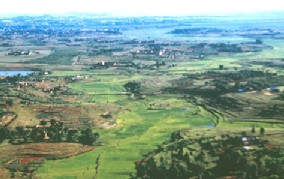|
afrol News, 24 March - The Royal Hill of Ambohimanga outside the Malagasy capital, Antananarivo, this week formally was included on the UNESCO World Heritage List, becoming the second Malagasy site on the list. Ambohimanga met three of the criteria for the inclusion to the List. The Royal Hill of Ambohimanga ("Blue Hill") consists of a royal city and burial site, and an ensemble of sacred places. It is associated with strong feelings of national identity, and has maintained its spiritual and sacred character both in ritual practice and the popular imagination for the past 500 years. It remains a place of worship to which pilgrims come from Madagascar and elsewhere. The Royal Hill of Ambohimanga is "the most significant symbol of the cultural identity of the people of Madagascar," according to the UN cultural agency; reason enough to include it in the World Heritage List. Further, the traditional design, materials, and layout of the Royal Hill of Ambohimanga are representative of the social and political structure of Malagasy society from at least the 16th century. Ambohimanga was also an "exceptional example of a place where, over centuries, common human experience has been focused in memory, ritual, and prayer." Ambohimanga has its roots in the 16th century, according to historians, or in the 14th century, according to oral traditions. It was one of many rivalling chieftaincies in the central plateau of the island, which during the 17th century slowly gained in local importance and power. In the late 18th century, the Ambohimanga-based chieftaincy conquered its neighbours and established the Imerina Empire.
The Imerina Empire grew the leading power on Madagascar under the reign of Andrianimpoinimerina (born at Ambohimanga, ca. 1745, dead 1810). Under the rule of Andrianimpoinimerina, the capital was moved to Antananarivo, but Ambohimanga remained an important ritual site. Until the French occupation in 1895, Imerina was to conquer most parts of the island. The Imerina royal house introduced a unique modernisation process in Madagascar in the late 19th century, even intending on industrialisation. With the baptism of Queen Ranavalona II in 1869, Christianity is made state religion. Obligatory school attendance is introduced in 1880, earlier than in most European countries. The last royal Malagasy Head of State was Queen Ranavalona III, exiled by the French in 1897. The Malagasy however still take pride in their ancient royal history and institutions. Ambohimanga, along with the Royal Palace in Antananarivo, remain the most important symbols of this proud past. Located some 21 kilometres northeast of the capital, Ambohimanga now also has become a popular tourist site and a retreat for Antananarivo city dwellers. The royal site, with restful gardens and astonishing views, is surrounded by hilltops and beautiful scenery, wonderfully cool and serene. The area is constituted of twelve hills, one of them being Ambohimanga. On Ambohimanga Hill, one finds a historic museum and the ancient royal swimming pool. The royal burial sites are located on two other hills, Ambohidratrimo and Antsahadinta. These tombs still play an important religious role in Madagascar, where the belief in the power of the ancestors is a key element in any religious practice, including Christianity, Islam or traditional religions. The royal burial sites therefore remain sacred. The World Heritage Committee, meeting in Helsinki in December last year, decided on the inscription of 31 new sites on the World Heritage List. The List now numbers 721 sites of "outstanding universal value" in 124 countries. The new List was published on Tuesday at a ceremony attended by UNESCO director general, Koïchiro Matsuura
|
front page
| news
| countries
| archive
| currencies
| news alerts login
| about afrol News
| contact
| advertise
| español
©
afrol News.
Reproducing or buying afrol News' articles.
You can contact us at mail@afrol.com

